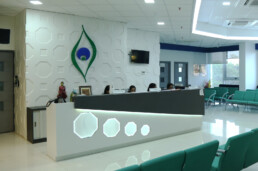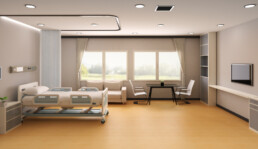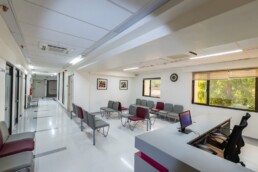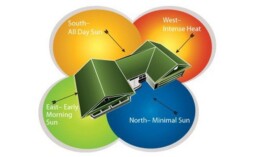Designing spaces in healthcare facilities tailor-made for children is a lesson in balance! A balance between functionality and flexibility, playfulness and serious medical care, comfort and state of the art technology. The critical element in this design is hope.
According to the Agency for Healthcare Research and Quality, nearly 6 million hospital stays involve teenagers, and 3 million patients are neonates. When dealing with such a vulnerable age group, it is essential to provide the right environment for optimal healing across the care continuum.
Here are five tips for creating healing spaces for kids in healthcare facilities.
1 – Light it Up!
It is no secret that the potential healing powers of the light and the sun have been used for centuries. Egyptians, Romans, Greeks, as well as civilisations in the east, including India, China and Tibet, have used natural light as a way to promote wellbeing and recovery. It is challenging to find ways to incorporate natural light in healthcare facilities, especially in urban areas. However, we can simulate the desired effect with the right combination of tone and placement of artificial light sources. LED lights that can be linked to motion sensors and timers, with a wide range of colour options, are replacing the harsh glare of fluorescent lights, traditionally used in healthcare facilities.

2 – Privacy Matters
Another factor that is often overlooked is how young patients value the opportunity to continue the “normal” aspects of their daily life, as much as possible. This can be facilitated through efforts to personalise their space and their social interactions, even at healthcare facilities. Privacy can range from single rooms to divided cubicles, depending on the size of the organization, but in addition to specific colours or themes, studies show that a focus on flexibility and customizability also plays a significant role.
3 – The Power of Positive Distraction
Architects are using design language to engage young patients and their families with age-appropriate positive distractions. The right combination of lighting, art, colour, texture, murals or green spaces has the power or transport children out of the hospital and into an enchanting forest, a dream city for kids, or an interactive garden. It may be a small respite from their daily stress but can make all the difference in their healing experience.
At Shree Designs, we found the perfect way to incorporate a little bit of magic into the waiting rooms of a prominent paediatrician. We used a garden theme for the clinic, and our hand-painted mural brought just the right touch of whimsy. Read about the entire project, linked here!
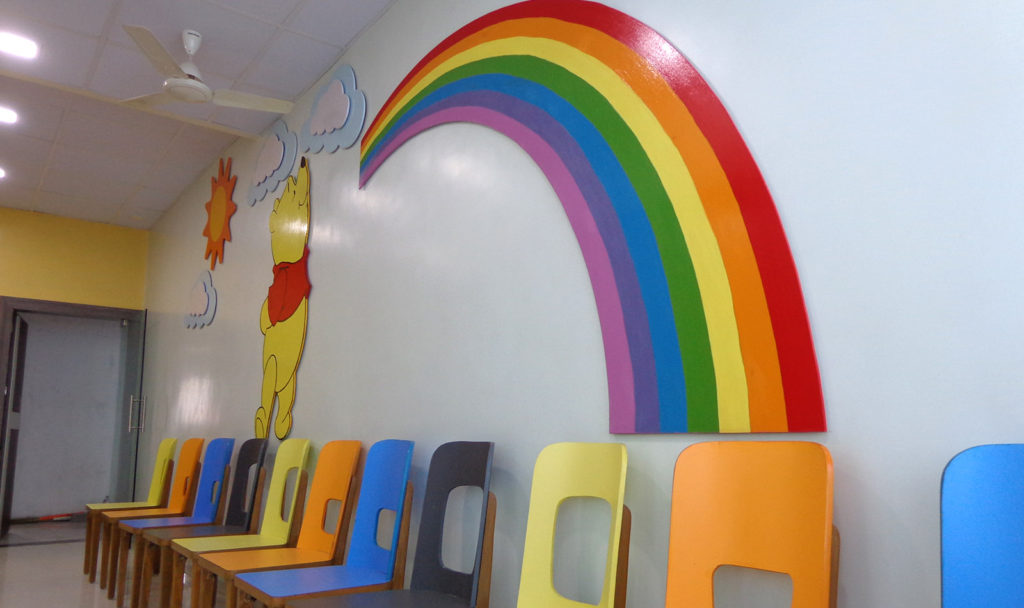
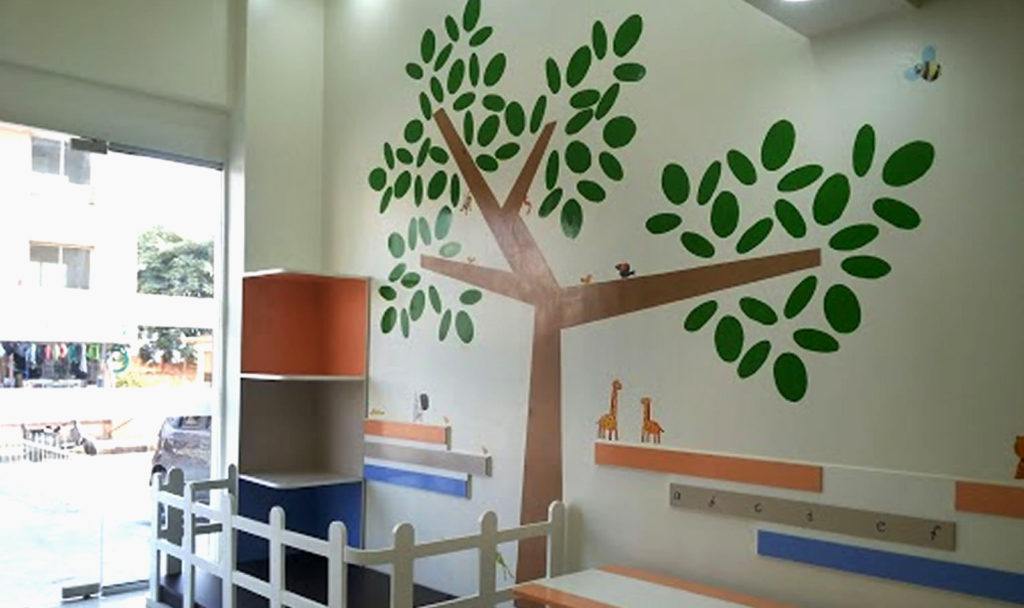
4 – Safety and Sterility
At Shree Designs, we incorporated these elements into our design while balancing the look and feel of the facility in our recent project at Neobliss Newborn Care, a Neonatal Intensive Care Unit in Mumbai, India. We included indirect lighting and soothing colours to create a calm setting. However, we also planned the ICU structure as per NABH standards with the following features to add to sterility:
When we go past the aesthetics, we need to make sure that the area is also functional. Again, safety and sterility are the key components that support healing, especially when dealing with newborns.
- Portable Air filtration of air for the ICU beds.
- HGPVC (Antimicrobial Wall Cladding) and a PVC cladding system that incorporated silver ion antimicrobial technology
- Gerflor Vinyl Flooring with a non-porous, water repellent and stain-resistant surface.
- Health Shield Paint (Anti-bacterial paint)
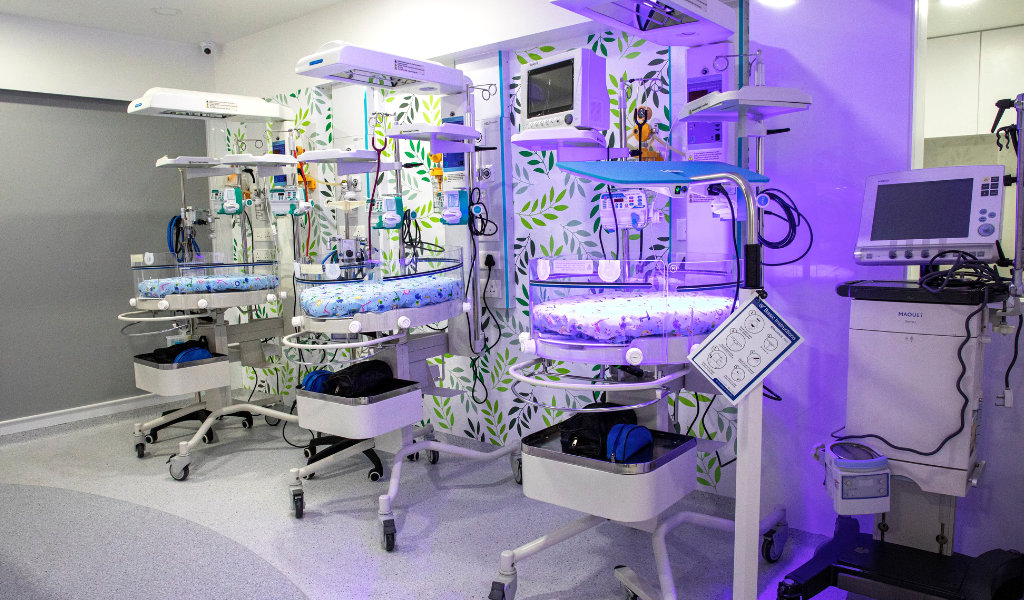
5 – Care for Caregivers
While children are the patients in paediatric wards, they are always accompanied by family members who also need to be accommodated during this stressful time.
Many organizations develop interactive play areas for siblings and flexible exam rooms that allow families to be present together.
Healthcare facilities who have an effective and simple wayfinding system designed to guide both adults and children from one space to another, is appreciated by the entire family, especially if they have to find their way across large campuses, with different buildings spread over a large area.
A hospital can be a scary place for a child and their family members. Surrounded by daunting medical equipment, going through lengthy medical procedures, and being away from their homes and loved ones make it easy for children to get overwhelmed.
“Our future design discussions need to involve patients and caregivers, observe how these individuals use spaces, and to ultimately see things such as they do. Only when we view the environment through the patient’s eyes shall we understand how to advance healthcare environments.”
Michael Graves. Architect
It’s time to inject some playfulness and get rid of the cold sterility in patient environments! When we introduce colour and light to brighten up healthcare facilities for children, we can vastly improve their experience.
Related Posts
Designing Healthcare Facilities
Textures in Healthcare Spaces
When designing hospitals or clinics, texture is often seen as a “finishing touch.” At Shree…
Infographic,Designing Healthcare Facilities
The Lifecycle of a Healthcare Facility Design
Ever wondered what goes into designing a hospital or clinic that actually works - clinically,…
Designing Healthcare Facilities
Designing NABH-Compliant Hospital Interiors
A well-designed hospital isn’t just about aesthetics. From fire safety and infection control to…
Designing Healthcare Facilities,Infographic
Blueprint for Healthcare Design
From room dimensions to lighting levels, every detail matters in healthcare design. At Shree…
Designing Healthcare Facilities
Building Better Day Surgery Centres
Efficient care, happier patients, and smarter workflows - this is what defines a successful…
Project Management,Designing Healthcare Facilities,Infographic
Designing Healthcare Spaces That Truly Heal
From concept to completion, every medical space we design prioritizes patient flow, staff…
Designing Healthcare Facilities
The Business of Wellness
In the $1.8 trillion wellness industry, first impressions matter. Patients don’t just choose a…
Designing Healthcare Facilities
Efficient Hospital and Clinic Design
India’s emerging cities are growing rapidly, creating an urgent demand for accessible and efficient…
Designing Healthcare Facilities
Creating Calming and Confidential Spaces for Fertility Clinics
As the demand for fertility treatments grows, the architecture of these clinics plays a vital role…
Designing Healthcare Facilities
Designing the Perfect Hospital Pharmacy
Hospital pharmacies are the backbone of seamless patient care. From efficient workflows to secure…
Designing Healthcare Facilities
Preventive Care Facility Design Strategies
With preventive care emerging as the future of healthcare, this post outlines key architectural…
Designing Healthcare Facilities
Thermal Comfort Decoded
Thermal comfort plays a critical role in patient recovery, staff productivity, and overall…
Designing Healthcare Facilities
Building for Tomorrow: The Imperative of Adaptable Healthcare Design
Healthcare facilities need to be as dynamic as the industry itself. Traditional, rigid designs can…
Designing Healthcare Facilities
Designing Single Speciality Healthcare Centres
As single-speciality centres grow, their design needs become more specific, calling for tailored…
Designing Healthcare Facilities
Innovative Design Solutions for Senior Care Facilities
Designing senior-friendly spaces in healthcare facilities is crucial for catering to the evolving…
Designing Healthcare Facilities
Designing a Dental Clinic for Success
Providing quality dental care is not just about the technical elements of the treatment. It's also…
Designing Healthcare Facilities
3 Essential Design Features for Intensive Care Units
ICUs are not just limited to single units housing all critical patients. If the facility has…
Designing Healthcare Facilities
3 Lessons Learned While Building a Cardiac Cath Lab
Cardiac care design is moving at the sound of a new beat! The number of Cath labs in India has…
Designing Healthcare Facilities
5 Essential Elements of Healthcare Design
Design makes a significant impact on the delivery of care for both healthcare providers and…
Designing Healthcare Facilities
Top 5 Trends in Healthcare Design
Design can make all the difference when it comes to improving patient care. From a patient’s point…
Designing Healthcare Facilities
The Architectural Design of Hospital Facilities
Shree Designs designed and executed many efficient and safe healthcare setups in the middle of the…
Designing Healthcare Facilities
Dauntless Designers
Healthcare Radius in its 7th Anniversary Special issue in October 2019, featured a "power list of…
Designing Healthcare Facilities
The changing face of healthcare design
After completing a decade in designing healthcare projects, Kshititi Nagarkar, principal architect,…
Designing Healthcare Facilities
Thumb Rules for Planning and Designing of Hospitals
Traditional rules of thumb in healthcare planning have changed. Once-accepted rules can now be the…
